Are you experiencing a tanning bed rash? Look no further!
As a Dermatologist with years of experience, I’ve seen many cases and conducted thorough research on this issue.
In this comprehensive guide, you’ll learn about the 7 common causes and prevention strategies for tanning bed rashes and more than 7 effective treatments to help soothe and heal your skin.
So, let’s dive in and learn how to protect your skin while enjoying the benefits of tanning beds!
Table of Contents
Key Takeaways
- Excessive heat, sweat, bacteria, and fungi can cause tanning bed rashes.
- Maintaining proper hygiene and cleanliness can help ease these pesky tanning bed rashes.
- Talk to your dermatologist for personalized advice and treatment options if you’re worried about anything!
Check: 5 Best Tanning Bed Bulbs
Tanning Bed Rash: What it Is and How Do You Prevent It?
So, you finally tried nude tanning, and you’re feeling pretty darn good about your beautiful bronze.
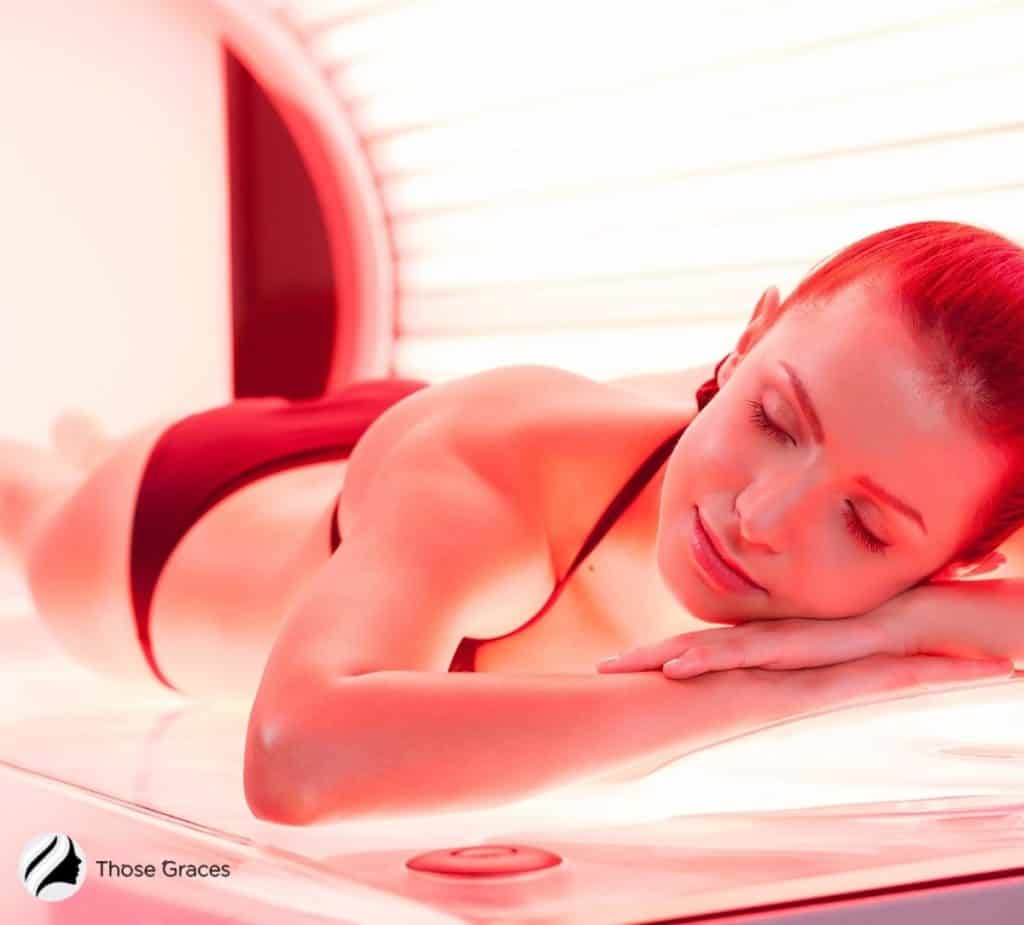
As you’re admiring your new look in the mirror, you notice something pretty gross: itchy bumps all over your body.
My friend, you’ve got a tanning bed rash. It sucks, right? Don’t freak out. Your days of enjoying a good tan aren’t over.
Bumps from a tanning bed can be prevented and treated. And this article will discuss all of that.
First, though, a quick disclaimer. I do not advocate any form of “natural†tanning in the sun or a bed. Neither is even remotely safe. Period. No “ifs, ands or buts.â€
That said, you’re an adult. You can make your own decisions. Just understand that these posts are merely for “informational†purposes.
Also, nothing in this post should be construed as medical advice. If you’re dealing with a blistering rash, see a doctor.
Want to know the truth about tanning? Check the video below:
Check: How Does Tanning Oil Work?
7 Common Causes of Tanning Bed Rashes
You’ve seen it, read about it in the papers, and maybe even experienced it while tanning – ugly red rashes!
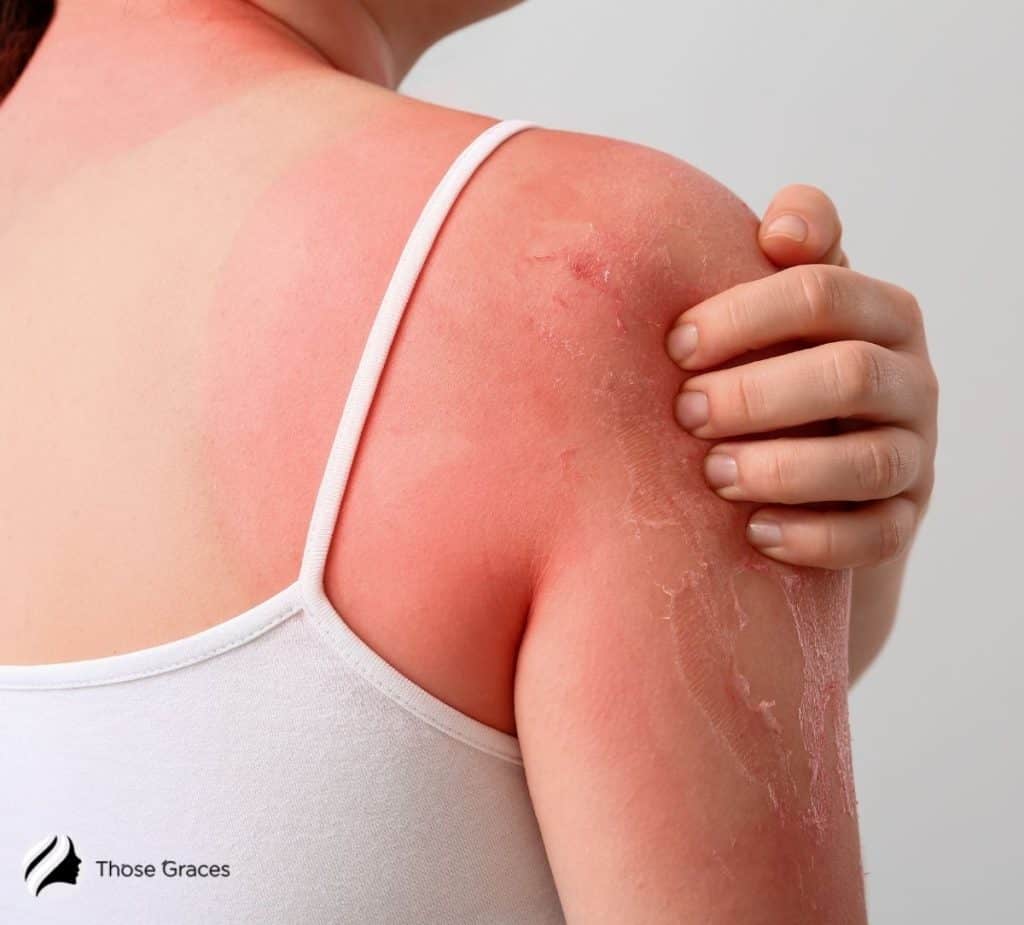
Ever wondered what causes all these horrible rashes? Here are the 7 reasons I’ve learned as a seasoned tanner…
1. Heat and Sweat: The Toasty Side of Tanning
Puzzled by something and sweating profoundly? Well, you came to one of the most common causes of tanning bed rashes – heat and sweat!
But did you know that the heat generated can also make you work up a sweat? When heat and sweat team up, they might cause pesky rashes if your tanning bed isn’t kept spick and span.
2. Bacteria and Fungi: The Green Nasties
Ever noticed that green stuff on your morning bread? That’s mold, also known as fungus.
Tanning beds create the perfect environment for these pesky microorganisms.
The heat generated can make you sweat whenever you relax in your tanning bed. If you skip your weekly cleans, these bed rashes can grow out of hand.
3. Allergies and Sensitivities: The Itchy Factors
Sneezing and wheezing may only be the common cold – but watch out!
People are not uncommon to be allergic or sensitive to chemicals in tanning bed lotions or the materials used in the tanning bed itself.
In the beginning, when I dabbled in my tanning adventures, I regularly got allergies until I found out what caused them – my infamous tanning lotions.
4. Photosensitivity and Medications: When Light Strikes a Sensitive Note
As a Dermatologist and seasoned tanning expert, I’ve encountered my fair share of photosensitivity situations.
The truth is that increased sensitivity to ultraviolet (UV) radiation can be a pesky side effect of certain medications, cosmetics, or medical conditions.
Take it from me: getting into a tanning bed while photosensitive is like inviting an uninvited, itchy rash to crash your party. Not fun!
5. UV Overexposure and Sunburn: Basking in Moderation
Picture this: you’ve spent too much time under those warm, glowing bulbs, and now you’re sporting a red, itchy rash – a sunburn, courtesy of your tanning bed.
I’ll be the first to admit that, in my earlier days, I might have gotten a bit overzealous with my tanning sessions. But I was young and silly back then.
6. Dry Skin and Irritation: As Dry as An Itchy Bone
You might be surprised to hear that dry skin can lead to rashes after a tanning session.
Over the years, I’ve seen many cases where a lack of proper hydration and moisturizing led to irritated, itchy skin.
7. Pressure Points and Friction – The Unwanted Souvenirs
Ever had those annoying red marks on your skin after a tanning session? I like to call them “unwanted souvenirs,” which are often caused by pressure points and friction.
Lying in a tanning bed for an extended period can pressure certain areas of your body, leading to uncomfortable rashes.
Head to the next section for an armchair biology lesson to learn about the grim symptoms…
Symptoms of Tanning Bed Rash
The symptoms of rashes from a tanning bed look different depending on the causes [1].
As a dermatologist and expert in the field, I’ve seen my fair share of these pesky skin nuisances. So, let’s dive in and explore the signs you should be on the lookout for:
- Itchy, scaly bumps or dry, red patches
- Tiny blisters or large, painful welts
- Sunburn-like redness and pain
Likewise, the blisters from a tanning bed can be itty-bitty or humungous. This also slightly differs from tanning bed burn symptoms.
If your rashes result from overexposure, they will probably look like sunburn.
These can be huge red blotches that are very painful or small discolored blisters that are only slightly itchy.
So, what does a typical tanning bed rash look like on your skin?
These rashes can come in various forms, such as clusters or patches of small, painful bumps or red blisters that resemble an allergic reaction.
The crazy part: It’s like your skin is throwing a surprise party, and you’re not invited!
Now, check out this video below to get an idea about the itchy welts that you could get after tanning:
Related: Must-Read Tanning Bed Tips
How To Treat Tanning Bed Rashes
Now that you know a bit about the causes of tanning bed rashes, take proactive measures. This way, you’ll enjoy a safer, more comfortable tanning experience.
The good news is that a tanning bed rash disappears quickly. And the bad news is, while it lasts, it can be irritating.
As a start, I recommend starting with a call to your doctor, then trying some simple home remedies!
So, without further ado, here are some things you can do to ease your pain and avoid infections…
1. Stop Tanning for a Few Days
If you’ve been using a tanning bed regularly and have never had a rash, there is a high probability that a break from the bed will solve the issue after a few days.
This works because chances are you got overambitious and overdosed on UV radiation to tan faster.
Giving your skin time allows it to absorb and eliminate excess UV radiation it’s currently working with.
Once the rash is gone, then you can start tanning again.
I know you want to speed up your tanning process. But tanning with a bed rash can make it worse and spread to other parts of your body.
2. Use Warm Water
The other thing you should do after you notice a rash is to wash the area with warm (not hot) water and antibacterial soap, such as the Dial Antibacterial Soap.
“If you start your tanning session with dry skin, tanning lamps can zap the moisture from the top layer of your skin,” warns Healthline’s experts [1].
To avoid this sticky situation, gently pat dry your skin and avoid hot or running water as it may cause further irritation.
3. Use a Cold Compress
This is another excellent hack for dealing with rashes after tanning. Apply a cold compress every day for 20 minutes until you heal.
I recommend the Arctic Flex Neck Pack cold compress as my go-to for soothing comfort to get back into the ebb and flow of soothing skin.
You’ll find that this relieves you of the pain and keeps your skin calm when healing rashes.
What’s great, a cold compress doesn’t have to be anything fancy. You can keep a soft cloth in cold water and hold it over the rashes.
Also, avoid clothes with fibers as they can make your skin dry and flaky, causing further irritation.
4. Use Oatmeal
I know you’re only familiar with oatmeal’s health benefits as a snack. But oatmeal can do much more when given a chance.
Oatmeal has avenanthramides that have anti-inflammatory properties that kill bacteria on the skin and normalizes the skin.
Here are some ways you can use oatmeal to heal your bed rash.
Take an oatmeal bath.
You might need a magazine or a wine glass for this one.
Prepare a bath to cover all the affected body rashes and relax for an hour.
Wipe off the oatmeal and moisturize your body. Watch a sample of an oatmeal bath in the video below.
Prepare an oatmeal taste.
If you’re too grossed out by the idea of taking an oatmeal bath, then a paste will do.
To make the paste, cook the oatmeal paste or add oatmeal to warm water.
Apply the mixture to the affected areas and allow it to dry.
5. Keep the Affected Area Clean and Don’t Rub It
Keeping any wound clean is always safe – This helps keep the bacteria away, which is critical if your skin is flaking.
Check out the Hypoallergenic Soft Gauze Pads from Netcare to smite these rashes. I’m a proud ambassador – my pads are my life, and I use them daily!Â
You’ll notice that once you wash the affected areas, you’ll lessen the annoying itchiness and boost your skin health.
Another creative tip to avoid this itchy beehive is to wear looser clothing!
By buying a size or a couple larger, you’ll find that your clothes will be softer and will rub less against your skin to create that itchy mess.Â
6. Apply an Antibacterial Cream
Antibacterial creams help your skin stay moisturized, which will prevent further cracking. Better yet, they will fight any bacterial growth that could cause other infections.
The best time to apply the antibacterial cream is after cleaning the wound before covering it with a bandage.
Which creams should you bet on?
Creams such as Neosporin and Polysporin are great! But as with any medication, consult your doctor before using it to ensure it’s safe and suitable for your skin!
7. Take an Antihistamine
This will depend on the cause of your tan rash. But to blow these rashes to smithereens, take an antihistamine if possible…
Antihistamine is helpful if your rash results from an allergic reaction to tanning products or cleaning chemicals used to clean the bed [2].
The medicine helps relieve the itchiness and reduce any symptoms of the tanning rash.
You can try over-the-counter options, including Benadryl and Claritin (just be sure to consult your doctor first).
You can watch this video for a quick review:
Pro recommendation: If you’re struggling with tanning bed rashes, consult a dermatologist for personalized advice and treatment options.
Other Simple Home Remedies for a Tanning Rash
They’re other ways you can deal with a tanning rash using simple ingredients. I always love home remedies because there is always a high chance I have the ingredients.
Here are the products you can use to deal with a tanning rash and why.
- Olive oil: The oil ensures your skin stays hydrated, preventing further cracking to reduce the rash.
- Aloe vera: It helps soothe your skin without any risk of side effects (unless you’re allergic to it) until the skin heals.
- Potato:Â This common veggie can help with tanning bed rashes by relieving pain and inflammation. Simply apply potato paste to the affected areas.
- Yogurt: I’m sure you’ve heard the praise of plain yogurt from your friends who are into intermittent fasting. Well, yogurt also helps in soothing inflammation, cleansing your skin, and removing irritants from your skin.
- Cucumber: This veggie has amazing hydrating properties that are great for dealing with dry skin rashes. It will keep your skin cool and allow you to heal from the rashes.
- Baking soda: A paste of baking soda on your rashes helps improve your skin’s pH level and heal the burns [3].
7 Expert Tips For Preventing Tanning Bed Rashes
Well, you’ve dealt with the annoying tanning bed rash, but how do you ensure you don’t experience this nasty experience again?
The obvious: stop trying to “tan naturally†and just use self-tanning lotions and sprays.
Never gonna happen? Great! Here are 7 different ways you can go about it:
1. Change your tanning products
After your skin heals, you can go back to tanning. However, ensure you get to the root of the tanning bed rashes.
If you suspect it has something to do with your tanning products, consider shifting to those made for sensitive skin.

2. Always carry hypoallergenic wipes with you
Besides ensuring that the tanning salons you go to have strict hygiene standards, carry baby wipes to wipe the tanning bed before using it.
Ensure the baby wipes you use don’t damage the tanning bed; otherwise, you’ll be in deep trouble with the owner.
3. Take it slow
I know you want to tan fast but don’t want to pay the cost of ugly, irritating rashes again.
Do you? I bet not.
Allow your tanning to be gradual, and reduce your hours on a tanning bed, sun, or any exposure to UV light.
Pro Tip: To keep your skin happy and healthy, follow the tanning bed’s recommended exposure times and gradually build up your tanning sessions.
4. Moisturize your skin
I can’t stress this enough. Whether you use a tanning lotion or not, moisturize your skin after tanning.
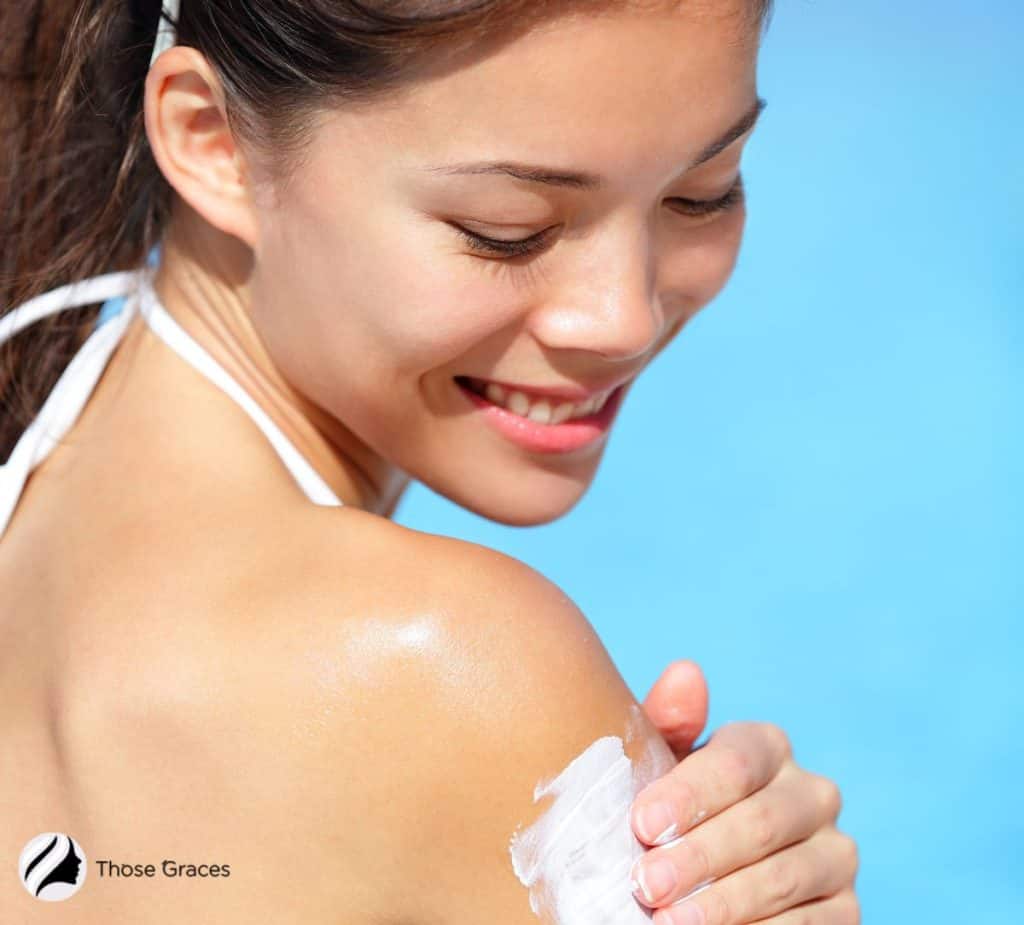
You’ll likely get rashes after tanning when your skin is flaky and dry.
5. Check Your Tanning Bed Hygiene
My regular tanning adventures taught me one thing: I always emphasize the importance of maintaining proper hygiene in tanning beds to prevent rashes.
Make sure to clean and disinfect the tanning bed regularly, and always use a clean towel while tanning. After all, your tanning bed – and general health – will thank you for it.
6. Limit Tanning Sessions
Going all out in your tanning sessions might seem like a good idea, but it’s better to take a more moderate approach.
Dr. Joel Schlessinger, a dermatologist and cosmetic surgeon, explains the reason behind this [4]:
“The lamps in tanning beds give off 10 to 15 times more radiation than the sun, making it a fallacy that they are somehow ‘safer.’“Â
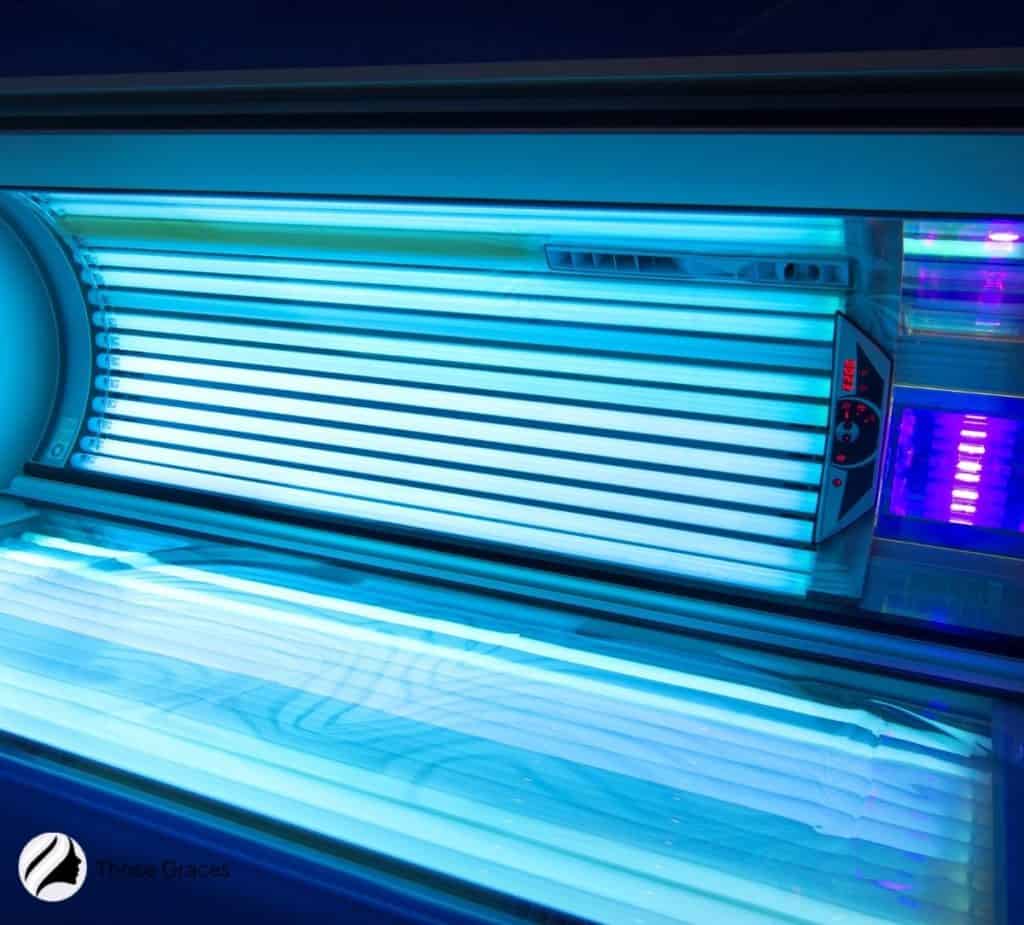
If you don’t want the rash gang to limit your life, the answer is clear: reduce exposure to protect your glowing skin as much as possible!
7. Wear Protective Gear
If you’re a sucker for old-fashion movies – like I am – you’ve certainly giggled when you saw funky-looking goggles on those pilots whopping in the wind, didn’t you? Guess what!
I think they were brilliant – here’s why: Wearing protective goggles and a barrier cream can help prevent skin irritation and rashes.
Protective gear can also reduce the risk of eye damage and other health issues associated with tanning beds.
FAQs
1. Can tanning beds cause skin cancer?
2. How can I prevent rashes from tanning beds?
3. What treatments are available for tanning bed rashes?
Tanning Bed Rash: How To Prevent It And Get Rid Of It (Conclusion)
Tanning is fun, and the results are excellent. But tanning bed rashes? Not so much!
But giving up all the perks of being a tanning queen is simply impossible.
It’s too much to ask.
So all I ask of you is to avoid overdoing it. Give it time and do it right to avoid nasty bed tanning rashes.
Also, avoid prolonged exposure to UV radiation, which can cause sunburn even in a tanning bed.
If you see tanning rashes after a tanning session, try some of the remedies suggested in this blog post.
But if it gets intense, gets out of hand – or otherwise drives you nuts – visit a specialist.
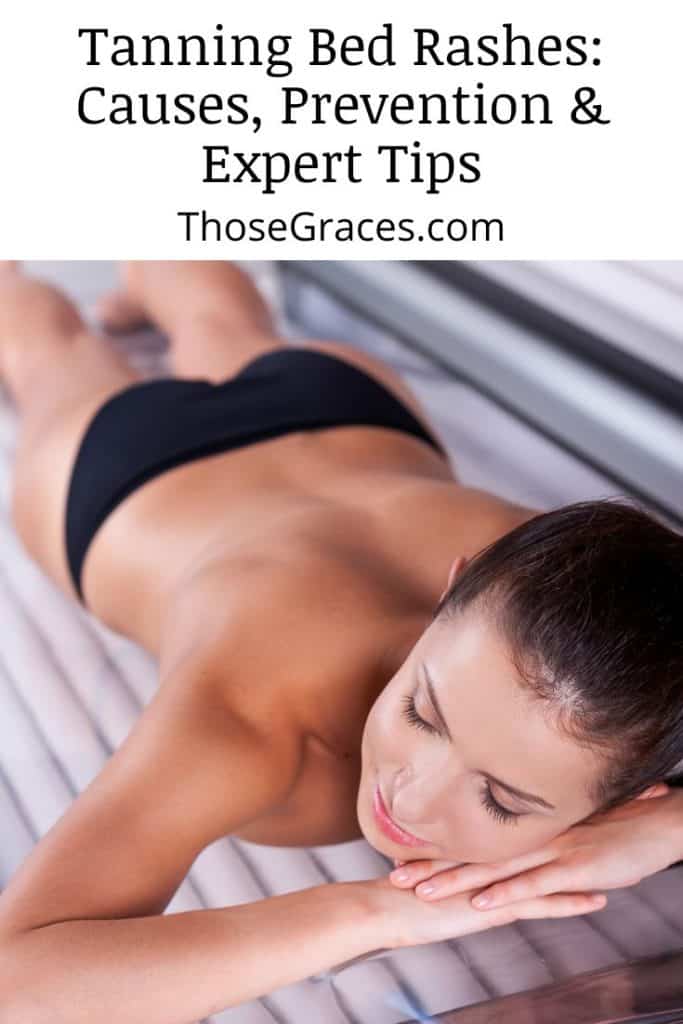
Resources
1. Watson K. Tanning Bed Rash: White Spots, Heat Rash, and Itchiness After Tanning [Internet]. Healthline. 2018 [cited 2023 Apr 12]. Available from: https://www.healthline.com/health/tanning-bed-rash#When-to-see-a-doctor
2. Watson S. Do I Need Antihistamines for Allergies? [Internet]. WebMD. WebMD; 2010. Available from: https://www.webmd.com/allergies/antihistamines-for-allergies
3. Cherney K. What’s so Important About Skin pH? [Internet]. Healthline. 25AD. Available from: https://www.healthline.com/health/whats-so-important-about-skin-ph
4. Sinrich J. dermatologist recommended skin care tips [Internet]. fashionista.com. 1AD. Available from: https://fashionista.com/2017/08/dermatologist-recommended-skin-care-tips



